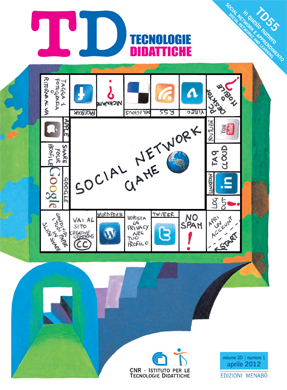I social media nell'educazione formale ed informale tra potenzialità e realtà
Contenuto principale dell'articolo
Abstract
Dettagli dell'articolo
Gli autori che pubblicano su questa rivista accettano le seguenti condizioni:
- Gli autori mantengono i diritti sulla loro opera e cedono alla rivista il diritto di prima pubblicazione dell'opera, contemporaneamente licenziata sotto una Licenza Creative Commons CC BY 4.0 Attribution 4.0 International License.
- Gli autori possono aderire ad altri accordi di licenza non esclusiva per la distribuzione della versione dell'opera pubblicata (es. depositarla in un archivio istituzionale o pubblicarla in una monografia), a patto di indicare che la prima pubblicazione è avvenuta su questa rivista.
- Gli autori possono diffondere la loro opera online (es. in repository istituzionali o nel loro sito web) prima e durante il processo di submission, poiché può portare a scambi produttivi e aumentare le citazioni dell'opera pubblicata (Vedi The effect of Open Access).
Riferimenti bibliografici
Apple M. (1979). Ideology and Curriculum. London: Routledge & Kegan Paul.
Baird D., Fisher M. (2009). Pedagogical Mash Up: Gen Y, Social Media, and Learning in the Digital Age. In L. T. W. Hin, R. Subramaniam R. (eds.). Handbook of Research on New Media Literacy at the K-12 Level: Issues and Challenges. Hershey, PA: IGI Global, pp. 48-71.
Bauman Z. (2010). 44 Letters from the Liquid Modern World. Cambridge, UK: Polity Press.
BBC News (2010). Facebook’s bid to rule the web as it goes social. BBC News Online, 22 April 2010, http://news.bbc.co.uk/1/hi/8590306.stm (ultima consultazione 09.12.2011).
Buckingham D. (2007). Beyond Technology: Childrens Learning in the Age of Digital Culture. Cambridge, UK: Polity Press.
Crook C. (2008). Theories of Formal and Informal Learning in the World of Web 2.0. In S. Livingstone (ed.). Theorising the Benefits of New Technology for Youth: Controversies of Learning and Development. ESRC seminar series: The educational and social impact of new technologies on young people in Britain, 12 March 2008, Department of Education, University of Oxford, Oxford, UK.
Crook C. (in stampa). The ‘Digital Native’ in Context: Tensions Associated with Importing Web 2.0 Practices into the School Setting. Oxford Review of Education.
Downes S. (2010). Deinstitutionising Education. Huffington Post, 2 November 2010, http://www.huffingtonpost.com/stephen-downes/ deinstitutionalizing-educ_b_777132.html (ultima consultazione 09.12.2011).
Gehl R. W. (2011). The Archive and the Processor: The Internal Logic of Web 2.0. New Media & Society, 13 (8), pp. 1228-1244.
Goodyear P., Ellis R. A. (2008). University Students’ Approaches to Learning: Rethinking the Place of Technology. Distance Education, 29 (2), pp.141-152.
Gouseti A. (2010). Web 2.0 and Education: Not Just Another Case of Hype, Hope and Disappointment?. Learning, Media and Technology, 35 (3), pp. 351-356.
Hargittai E. (2008). Whose Space? Differences Among Users and Non-Users of Social Network Sites. Journal of Computer-Mediated Communication, 13 (1), pp. 276- 297.
Hargittai E., Hsieh Y. P. (2010). From Dabblers to Omnivores: A Typology of Social Network Site Usage. In Z. Papacharissi (ed.). A Networked Self: Identity, Community, and Culture on Social Network Sites. London: Routledge, pp. 146-168.
Head A. J., Eisenberg M. B. (2010). How Today’s College Students Use Wikipedia for Course-Related Research. First Monday, 15 (3), 1 March 2010, http://firstmonday.org/htbin/cgiwrap/bin/ojs/index.php/ fm/article/view/2830/2476 (ultima consultazione 09.12.2011).
Hosein A., Ramanau R., Jones C. (2010). Learning and Living Technologies: A Longitudinal Study of First-Year Students’ Expectations and Experiences in the Use of ICT. Learning, Media and Technology, 35 (4), pp. 403-418.
Jones S., Johnson-Yale C., Millermaier S., Perez F. S. (2009). U.S. College Students’ Internet Use: Race, Gender and Digital Divides. Journal of Computer-Mediated Communication, 14 (2), pp. 244-264.
Lankshear C., Knobel M. (2006). New Literacies: Changing Knowledge and Classroom Learning. Buckingham, UK: Open University Press.
Lee M., McLoughlin C. (2010). Web 2.0-Based E-Learning: Applying Social Informatics for Tertiary Teaching. Hershey, PA: IGI Global.
Margaryan A., Littlejohn A., Vojt G. (2011). Are Digital Natives a Myth or Reality? University Students’ Use of Digital Technologies. Computers & Education, 56 (2), pp. 429-440.
Mason R., Rennie F. (2007). Using Web 2.0 for Learning in the Community. The Internet and Higher Education, 10 (3), pp. 196-203.
Mayer A., Puller S. (2008). The Old Boy (and Girl) Network: Social Network Formation on University Campuses. Journal of Public Economics, 92 (1-2), pp. 329-347.
O’Reilly T. (2005). What is Web 2.0? Design Patterns and Business Models for the Next Generation of Software, http://oreilly.com/web2/archive/what-is-web-20.html (ultima consultazione 09.12.2011).
Schradie J. (2011). The Digital Production Gap: The Digital Divide and Web 2.0 Collide. Poetics, 39 (2), pp. 145-168.
Selwyn N. (2009). Faceworking: Exploring Students’ Education-Related Use of Facebook. Learning, Media and Technology, 34 (2), pp. 157-174.
Shirky C. (2008). Here Comes Everybody: The Power of Organizing Without Organizations. London: Penguin Press.
Solomon G., Schrum L. (2007). Web 2.0: New Tools, New Schools. Eugene, OR: International Society for Technology in Education.
Song F. (2010). Theorising Web 2.0. A Cultural Perspective. Information, Communication and Society, 13 (2), pp. 249-275.
Standish P. (2008). Preface. Journal of Philosophy of Education, 42 (3-4), pp. 349-353.
Willinsky J. (2009). Foreword. In C. Vrasidas, M. Zembylas, G. Glass (eds.). ICT for Education, Development and Social Justice. Charlotte, NC: Information Age Publishing, pp. ix-xvi.

